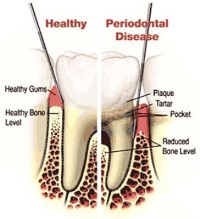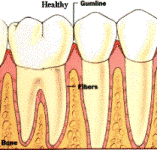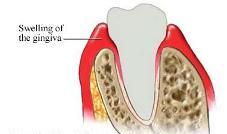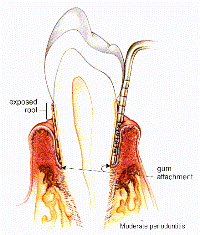
|


What is Periodontal Disease?

The American Academy of Periodontology defines periodontal (gum) diseases, including gingivitis and periodontitis, as serious infections that, if left untreated, can lead to tooth loss. The word periodontal literally means "around the tooth." Periodontal disease is a chronic bacterial infection that affects the gums and bone supporting the teeth. Periodontal disease can affect one tooth or many teeth. It begins when the bacteria in plaque (the sticky, colorless film that constantly forms on your teeth) causes the gums to become inflamed.
What causes periodontal disease?
1.) Bacteria normally present in the human mouth are not a problem to us as long as they are prevented from getting together in large colonies and from producing plaque. Plaque is a sticky substance that allows colonies of bacteria to stick to your teeth. There they use the foods that you eat to make acid (which causes dental cavities) and other toxins (poisons) which are harmful to the gum tissue and supporting bone.
The lips, cheeks, and tongue clean the big broad surfaces of the teeth, but cannot clean the area between the teeth, or below the gum line. These are the areas where bacteria can do its dirty work, totally undisturbed.
2.) Oral conditions and habits - defective fillings, poor-fitting crowns or bridges, crowded, crooked teeth, ill-fitting partial dentures, and habits like grinding or clenching your teeth.
3.) Physical and chemical irritants - packing food between the teeth, smoking or chewing tobacco, excessive alcohol consumption.
4.) Certain Medications - anti-epilepsy drugs, cancer-therapy drugs, and any medications that can make the mouth drier than normal can affect the gums.
5.) Pregnancy or oral contraceptives - these may affect hormone balance and cause the gum tissue to be more sensitive to irritants.
Stages of periodontal disease:
1.) Healthy gingiva (gums):

Gums are tight to the tooth, uniform pink in color; pocket depth (with the probe) is 0-2 mm (millimeters); gums do not bleed when brushing; pink or coral pink color (normal variations in color depend on race and complexion); firm, resilient tissues; "orange-peel' texture (known as stippling); shape that follows the contour of the teeth and forms a scalloped edge; no areas of redness, swelling or inflammation; no bleeding during daily plaque removal; no discomfort
2.) Gingivitis:

This occurs due to inadequate brushing and flossing . Toxins in the plaque cause the tissue to swell, become irritated and red, and to bleed easily. The bone surrounding the teeth is still intact, and this is a SOFT TISSUE condition only. The effects of gingivitis can be reversed with a professional cleaning and good brushing and flossing. Pocket depths are 2-3 mm.
3.) Periodontitis:

The bacteria colonies are well-established under the gumline and between the teeth The gums can no longer attach to the tooth where they used to due to the mass of bacterial plaque. Bone destruction occurs due to the inflammation and infection below the gum line. As the gums detach from the teeth, the bacteria goes even deeper into the pockets formed. The pocket depth now goes beyond 3 mm. Tooth roots become exposed, and these areas become sensitive to temperature and to root decay.
4.) Advanced periodontitis:
The structures supporting the tooth continue to be destroyed. In some cases there is almost no bone support for the teeth. Teeth are loose, and may fall out or need to be extracted.
Adult gum disease is usually not painful. It can progress slowly. You may not even be aware of it until the advanced stages, when the tooth is in danger of being lost. Check your gums thoroughly and regularly. It is also important to go for regular checkups (at an interval schedule determined through collaboration with your oral health professional, based on your own personal needs). Your dentist or dental hygienist can detect the early stages of gum disease, when it is the easiest to treat.
What can I do to prevent periodontal disease?
Periodontal disease is an IN-BETWEEN-The-TEETH disease.
If you want to prevent periodontal disease, you need to FLOSS and BRUSH below the gum line around each of your teeth
.
|
|
|
|
|
|
